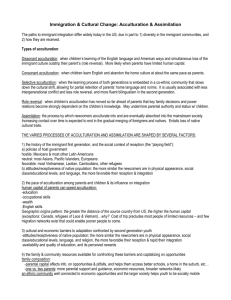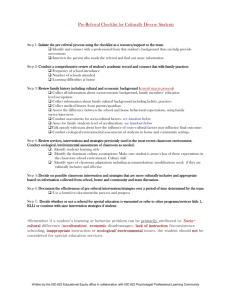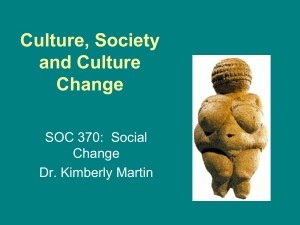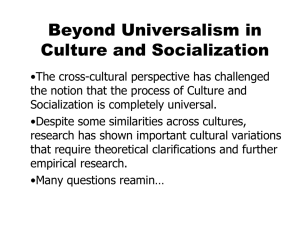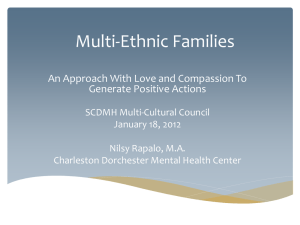Running Head: Sensitive Period for Acculturation 1 Evidence for a
advertisement
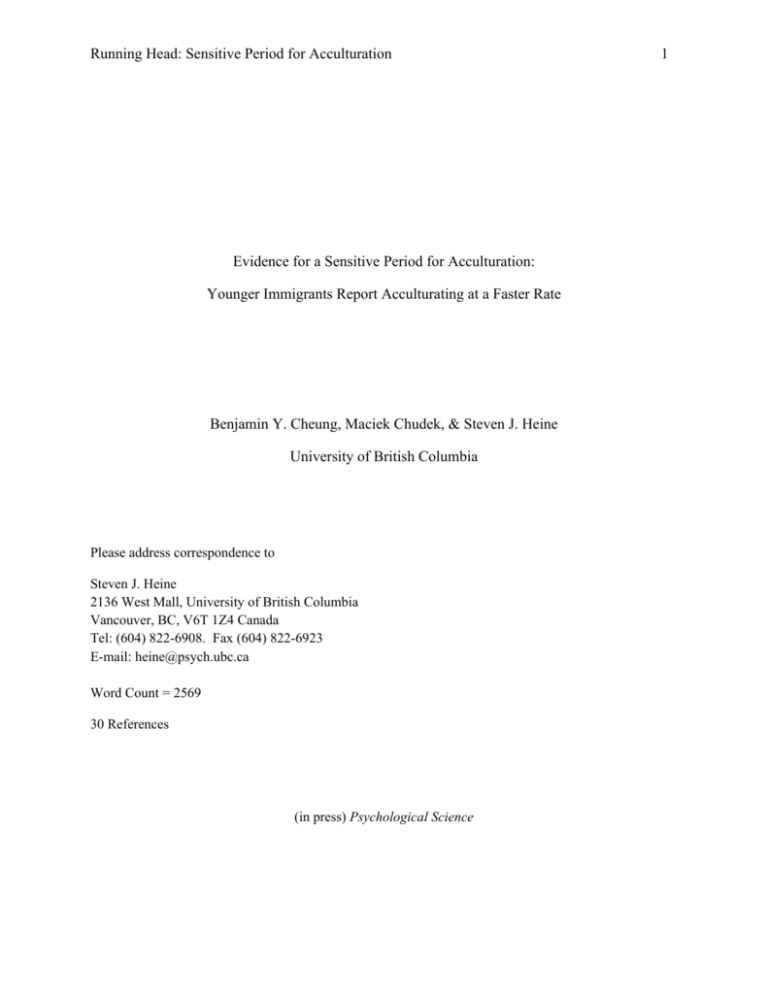
Running Head: Sensitive Period for Acculturation Evidence for a Sensitive Period for Acculturation: Younger Immigrants Report Acculturating at a Faster Rate Benjamin Y. Cheung, Maciek Chudek, & Steven J. Heine University of British Columbia Please address correspondence to Steven J. Heine 2136 West Mall, University of British Columbia Vancouver, BC, V6T 1Z4 Canada Tel: (604) 822-6908. Fax (604) 822-6923 E-mail: heine@psych.ubc.ca Word Count = 2569 30 References (in press) Psychological Science 1 SENSITIVE PERIOD FOR ACCULTURATION 2 Abstract Though recent adults immigrants often seem less acculturated to their new society than those who immigrate as children, it’s not clear whether this is driven by duration of exposure or exposure during a sensitive developmental period. To disambiguate these influences community and student samples of Hong Kong immigrants to Vancouver completed the Vancouver Index of Acculturation (VIA), a measure that assesses participants’ identification with both their mainstream and heritage cultures. A longer duration of exposure was found to be associated with greater identification with Canadian culture only at younger ages of immigration, but not at later ages of immigration. Conversely, identification with Chinese culture was unaffected by either age of immigration or by length of exposure. These findings provide evidence for a sensitive period for acculturation in which people are better able to identify with a host culture with increased exposure, but only at a younger age. SENSITIVE PERIOD FOR ACCULTURATION 3 Acculturation is the process of cultural adaptation that people undergo upon relocating from a heritage culture to a new host culture (for reviews, see Sam & Berry, 2006; Ward, Bochner, & Furnham, 2001). Humans have likely been crossing cultural boundaries since before Homo sapiens left Africa, and psychologists have investigated acculturative processes since Redfield, Lindon, and Herskovits (1936) first explicated recommendations for studying the acculturation experience. Researchers, from a variety of fields, have investigated such questions as how moving to a new culture is associated with intergenerational conflict (e.g., Lim, Yeh, Liang, Lau, & McCabe, 2009), consequences for physical health and psychological well-being (e.g., Berry & Annis, 1974), and how features of an individual’s culture or personality alter their likelihood of experiencing acculturative difficulties (e.g., Berry, Kim, Power, Young, & Bujaki, 1989; Ward, Leong, & Low, 2004). One important question has thus far been largely neglected by acculturation researchers – is there a developmental period within which people are especially adept at adjusting to a new culture? There are strong theoretical grounds for suspecting the existence of a sensitive acculturation period. Evolutionary biologists, ecologists, and developmentalists emphasize the tradeoffs inherent in phenotypic plasticity (e.g., DeWitt, Sih & Wilson, 1998; Pigliucci, 2005; Auld, Agrawal & Relyea, 2010) – that is, the decision by an organism (or its genome) to invest valuable time, energy and resources in learning new behaviors better-suited to its environment, rather than specializing in exploiting behaviors it has already mastered. Too little developmental time invested in learning produces poorly adapted phenotypes, whereas, an over-expenditure of developmental time and resources for learning produces organisms easily outcompeted by their more rapidly specialized peers. SENSITIVE PERIOD FOR ACCULTURATION 4 The optimal resolution of this tradeoff depends on the costs and benefits of learning and specialization (among other variables), and individuals and species vary tremendously in when they terminate learning for specialization. Many species invest in costly specialization based on in utero learning (e.g., Agrawal, Laforsch & Tollrian, 1999), others make this decision shortly after birth (e.g., gosling imprinting), while humans have (in some domains) exceptionally plastic phenotypes and long developmental periods. While it is plausible that the genetic adaptations that enabled humans to accumulate culture also created a system that emphasizes learning over specialization across all development periods, it seems more likely that human cultural learning is continuous with learning across other domains and species!""That is, it transitions at a critical developmental juncture from acquisition (an emphasis on learning new cultural traits, skills and norms) to specialization (an emphasis on better exploiting those already acquired). The question of whether there is a sensitive acculturation period is informed by evidence of sensitive periods in a broad array of domains, such as the acquisition of absolute pitch (Chin, 2003), susceptibility to the Mueller-Lyer illusion (McCauley & Henrich, 2006), and acquiring binocular vision (Banks, Aslin, & Letson, 1975; for a review see Werker, Maurer, & Yoshida, 2009). In particular, there is much evidence for a sensitive period for acquiring language, whose phylogenetic origins are closely linked to humans’ capacity for cultural learning. The ability to acquire various aspects of language, such as accent, grammar, and syntax, diminishes with age (e.g., Lenneberg, 1967) for both first (e.g., Mayberry, 1993) and second language acquisition (e.g., Johnson & Newport, 1989). Further, there is evidence that second languages are processed in distinct regions of the brain depending on the age at which the individual acquired them (e.g., Kim, Relkin, & Lee, 1997). As second language acquisition involves the acquisition of a second cultural meaning system, a sensitive window for second language acculturation may be SENSITIVE PERIOD FOR ACCULTURATION 5 suggestive of a similar sensitive window for acculturation. Does acculturation show similar evidence for a sensitive period of development, or do people acculturate at the same rate regardless of age? Research on an “acculturative gap” (Lim et al., 2009) provides indirect evidence for such a period, as immigrant children appear to have acculturated more quickly than their parents. A sensitive period implies that people’s rates of acculturation (operationalized as the change in their identification with their new culture, per year) are dependent upon their age of immigration. We have found only two studies that provide initial evidence for such a sensitive acculturation period: Tsai, Ying, and Lee (2000) found that Chinese who immigrated to the US before the age of 12 identified more strongly with American ways of life than those who immigrated after the age of 12. Likewise, Minoura (1992) found that Japanese children who had moved to the US before the age of 15 reported that American experiences felt more natural to them. However, participants in both studies were similarly aged when they were interviewed (college age in Tsai et al., and high school age in Minoura); thus the age of arrival and the length of time in the host culture are largely confounded, preventing this evidence from elucidating whether rates of acculturation change with age of immigration. This is a critical point as an alternative hypothesis to a sensitive period for acculturation is that people acculturate at a rate independent of their age of immigration, so that the longer one spends in a culture, the more they should have adjusted to it. To obtain clear evidence for a sensitive period it is necessary to disentangle the age of immigration from the number of years people had spent in the host culture. This can be done by targeting participants of a broad range of ages, who had immigrated at different points in their lives, and who had spent varying numbers of years in the host culture. SENSITIVE PERIOD FOR ACCULTURATION 6 The present study sought to assess the evidence for a sensitive period of acculturation among Hong Kong immigrants in Vancouver, Canada. Hong Kong immigrants represent a substantial proportion of immigrants to Vancouver, constituting close to 10% of the population of Greater Vancouver (Statistics Canada, 2008a). Furthermore, several waves of Hong Kong immigrants have arrived in Vancouver over recent decades, many of whom arrived with family members of different ages. This broad range of both age of immigration and years spent in Canada, makes this an ideal population for our study. Methods Participants Participants were 2321 Hong Kong immigrants to Vancouver (141 females), ages 18 to 60 (M = 33.05, SD = 14.15). The age of immigration ranged from 1 to 50 (M = 19.53, SD = 14.03), and the number of years spent in Canada ranged from 2 to 39 (M = 13.41, SD = 5.18). The sample was recruited from a local Chinese immigrant aid organization (S.U.C.C.E.S.S.; n = 171) and from the student population of the University of British Columbia (n = 61). Participation was restricted to immigrants from Hong Kong who had not spent more than 2 years in a country other than Hong Kong/China, Canada, or the US. Materials Because the language within which people are assessed can affect their responses (e.g., Ross, Xun, & Wilson, 2002), we created both Chinese and English versions of our materials, and statistically controlled for the language version that participants received (English was coded as 1 and Chinese as 2). Participants rated their reading comprehension in Chinese and English and """"""""""""""""""""""""""""""""""""""""""""""""""""""""""" 1 Though note that effective sample sizes for statistical inferences were sometimes smaller due to some participants not answering some questions. These are reported in Table 1. SENSITIVE PERIOD FOR ACCULTURATION 7 received the study in whichever language they rated higher. Those who rated themselves as equally proficient in both languages were randomly assigned language versions. The Chinese version was translated by two bilingual speakers, and disagreements were reconciled through discussion to produce the final translation (see Heine, 2008). Acculturation was measured with the Vancouver Index of Acculturation (VIA: Ryder, Alden, & Paulhus, 2000), which, like much of the acculturation literature (e.g., Berry et al., 1989; LaFromboise, Coleman, & Gerton, 1993), conceptualizes acculturation as a bidimensional construct composed of orthogonal scales representing one’s identication with one’s heritage and mainstream culture. Participants were first provided with a definition of the term “heritage culture,” and were then asked to indicate their own heritage culture prior to completing the scale. This measure has been found to be highly reliable with Chinese samples (Huynh, Howell, & Benet-Martínez, 2009). The obtained Cronbach’s alphas for each subscale were 0.87 and 0.85 for the mainstream and heritage scales, respectively. Sample items from the mainstream scale include “I enjoy typical North American jokes and humor,” and for the heritage scale, “It is important for me to maintain or develop the practices of my heritage culture.” Results To examine whether our participants’ rate of acculturation, as measured by their mainstream score on the VIA scale, declined as a function of age of immigration, we analysed the interaction between their years in Canada (YIC) and their age of immigration (AOI; which themselves are correlated at r = -.17, p = .01) as a predictor of their mainstream score. Our Ordinary Least Squares model also controlled for the following covariates: the participants’ gender, their self-reported English ability, their questionnaire’s language version, and whether SENSITIVE PERIOD FOR ACCULTURATION 8 they were community or undergraduate samples (age cannot simultaneously be examined as a covariate as it is the sum of YIC and AOI, producing a degenerate (i.e. not invertible) predictor matrix which cannot be regressed). Of these covariates, only sample population had even a marginally significant influence on mainstream culture: undergraduates reported higher mainstream identification (B = .318, p = .09). Although self-reported English ability did not significantly predict mainstream identification (p = 0.15), it did correlate substantially with AOI (r = -0.55, p< 0.001). The details of this model are presented in Table 1. A linear relation between AOI and mainstream identification was significant, indicating that with each increasing year of AOI, people who had been in Canada the average length of time (approximately 13.4 years) scored .024 points less on their mainstream identification (see left panel of Figure 1). This effect was qualified by a significant interaction between age of immigration and years spent in Canada, revealing that with each increasing year of AOI, their rate of increase in Mainstream identification fell by 0.003 points. For individuals who immigrated before approximately age 14.52, this rate was significantly positive. Subsequently, it was within conventional significance bounds of zero, and became nominally negative at approximately age 25. Though none of our participants arrived in Canada over the age of 50, linear extrapolation from our model suggests that the rate of acculturation would have become significantly negative at age 51. These relationships are visually apparent in the right panel of Figure 1. The 3-way interaction between AOI, YIC, and English ability was not significant (p = 0.63), indicating that this effect was consistent across participants, regardless of their selfreported English ability at the time they participated. """"""""""""""""""""""""""""""""""""""""""""""""""""""""""" 2 Linear extrapolation by solving for AOI at the critical t-distribution value (t.025,202), given the interaction-dependent standard error of AOI simple slopes. All values to reproduce this calculation are available in the table, besides the covariance between YIC and interaction coefficients: cov(!YIC, !YIC*AOI) = -0.00003 SENSITIVE PERIOD FOR ACCULTURATION 9 A similar analysis of heritage scores yielded no significant predictors; neither age of immigration nor years in Canada was related to heritage identification. Discussion The present analysis provides initial support for a sensitive period of acculturation to mainstream Canadian culture among Hong Kong immigrants to Vancouver. The younger the people were at the time of immigration the more rapidly they came to identify with Canada. Furthermore, mainstream identification among younger immigrants increased the longer they stayed in Canada, but the opposite was (nominally but not statistically significantly) true of older immigrants. Apparently, acculturation occurs most rapidly at younger ages, providing evidence for a sensitive period of acculturation. Although these effects occurred independently of participants’ self-reported English ability, it is possible that a more sensitive language measure, or longitudinal measure of language ability in the formative months and years after arrival, would have revealed that acculturation is a function of differential mastery of more subtle nuances of language-learning. Curiously, neither the age of immigration nor the number of years spent in Canada predicted participants’ identification with Chinese culture. It remains to be seen what factors influence identification with one’s heritage culture (although note that Ryder et al., 2000 found that years/generations in Canada negatively predicted heritage identification). This is further evidence that the two dimensions of acculturation, identification with mainstream and heritage culture, are independent. Our findings may be idiosyncratic to Hong Kong immigrants in Vancouver due to their relatively high concentration, limiting the generalizability of our results. Indeed, Chinese immigrants (of which approximately 36% are from Hong Kong; Statistics Canada, 2008b) are the largest immigrant population in Greater Vancouver, and the city’s SENSITIVE PERIOD FOR ACCULTURATION 10 Chinatown is the second largest of its kind outside of Asia (Burgess, 2005). Perhaps this concentration of Chinese immigrants, and concomitant cultural amenities, contributed to our observed pattern of results. These factors may explain why heritage identification was independent of years in Canada or age of immigration. This is in line with findings from linguistics suggesting that regular exposure to one’s native language in childhood allows for the maintenance of native-like performance on some language tasks (Oh, Jun, Knightly, & Au, 2003). The large Chinese community in Vancouver may serve as the cultural analog for regular language exposure, allowing Hong Kong immigrants to maintain their heritage identification. It will be important to assess how acculturation patterns emerge with other immigrant populations and other host cities. One unexpected finding was the pattern that older immigrants showed a negative relationship between years spent in Canada and mainstream identification. This pattern may be due to individuals becoming increasingly frustrated by an environment where the cultural phenotype in which they have specialized fits poorly into their new community’s norms, a natural aging process where people generally become dissatisfied with the contemporary culture as they age, a particular cohort effect (e.g. the effects of older immigrants’ experiences with the Cultural Revolution) or simply random sampling error. More generally, the cross-sectional design of this study raises the possibility for other kinds of cohort effects underlying the results: for example, those who immigrated at younger ages might have had different levels of income, education, or reasons for leaving the country than those who came at older ages. Longitudinal studies would be better able to address these possibilities. Also, the context of one’s experiences in a host culture likely varies with age of immigration such that those who arrive at a younger SENSITIVE PERIOD FOR ACCULTURATION 11 age participate in the culture differently (e.g., attending elementary school, engaging in more team sports) than those who arrive later, which might partly account for our results. The present study assessed people’s conscious thoughts about their identification to Canada and Hong Kong, and it’s possible that their unconscious thoughts or acculturative behaviors might show a different pattern. It remains to be determined whether other aspects of acculturation occur across a similar timeline. There are three potential patterns of results that might emerge from the investigation of sensitive periods for other aspects of acculturation: (1) all cultural processes adapting at similar rates; (2) different processes independently adapting at different rates; or (3) a cascading adaptation process where the adaptation of one process depends on the adaptation of another. Future research would benefit by investigating a broad range of psychological measures that are known to differ across cultural groups to assess which of the above three models of adaptation best characterize acculturative processes. SENSITIVE PERIOD FOR ACCULTURATION 12 References Agrawal, A. A., Laforsch, C., & Tollrian, R. (1999). Transgenerational induction of defences in animals and plants, Nature, 401(6748), 60-63 Auld, J. R., Agrawal, A. A., & Relyea, R. A. (2010). Re-evaluating the costs and limits of adaptive phenotypic plasticity. Proceedings. Biological sciences / The Royal Society, 277(1681), 503-11. Banks, M. S., Aslin, R. N., & Letson, R. D. (1975). Sensitive period for the development of human binocular vision. Science, 190, 675-677. Berry, J. W., & Annis, R. C. (1974). Acculturation stress: The role of ecology, culture, and differentiation. Journal of Cross-Cultural Psychology, 5, 382-406. Berry, J. W., Kim, U., Power, S., Young, M., & Bujaki, M. (1989). Acculturation attitudes in plural societies. Applied Psychology: An International Review, 38, 185-206. Burgess, A. C. (Ed.). (2005). Insiders' guide: Guide to Western Canada (7th ed.). Guilford: The Globe Pequot Press. Chin, C. S. (2003). The development of absolute pitch: A theory concerning the roles of music training at an early developmental age and individual cognitive style. Psychology of Music, 31, 155-171. DeWitt, T., Sih, A., & Wilson, D. S. (1998). Costs and limits of phenotypic plasticity. Trends in Ecology & Evolution, 13(2), 77-81. Heine, S. J. (2008). Cultural Psychology. New York: W. W. Norton. SENSITIVE PERIOD FOR ACCULTURATION 13 Huynh, Q.-L., Howell, R. T., & Benet-Martínez, V. (2009). Reliability of bidimensional acculturation scores. Journal of Cross-Cultural Psychology , 40 (2), 256-274. Johnson, J., & Newport, E. L. (1989). Critical period effects in second language learning: The influence of maturational state on the acquisition of English as a second language. Cognitive Psychology, 21, 60-99. Kim, K. H. S., Relkin, N., & Lee, K. (1997). Distinct cortical areas associated with native and second languages. Nature, 388, 171-174. LaFromboise, T., Coleman, H. L. K., & Gerton, J. (1993). Psychological impact of biculturalism: Evidence and theory. Psychological Bulletin, 114, 395-412. Lenneberg, E. H. (1967). Biological Foundations of Language. New York, NY: Wiley. Lim, S.-l., Yeh, M., Liang, J., Lau, A. S., & McCabe, K. (2009). Acculturation gap, intergenerational conflict, prenting style, and youth distress in immigrant Chinese American families. Marriage & Family Review , 45, 84-106. Mayberry, R. I. (1993). First-language acquisition after childhood differs from second-language acquisition: The case of American Sign Language. Journal of Speech and Hearing Research, 36, 1258-1270. McCauley, R. N., & Henrich, J. (2006). Susceptibility to the Muller-Lyer Illusion, theory-neutral observation, and the diachronic penetrability of the visual input system. Philosophical Psychology, 19, 1-23. Minoura, Y. (1992). A sensitive period for the incorporation of a cultural meaning system: A study of Japanese children growing up in the United States. Ethos , 304-339. SENSITIVE PERIOD FOR ACCULTURATION 14 Oh, J. S., Jun, S.-A., Knightly, L. M., & Au, T. K.-F. (2003). Holding on to childhood language memory. Cognition , 86, B53-B64. Pigliucci, M. (2005). Evolution of phenotypic plasticity: where are we going now? Trends in ecology & evolution, 20(9), 481-6. Redfield, R., Linton, R., & Herskovits, M. J. (1936). Memorandum for the study of acculturation. American Anthropologist , 38 (1), 149-152. Ross, M., Xun, W. Q. E., & Wilson, A. E. (2002). Language and the bicultural self. Personality and Social Psychology Bulletin, 28, 1040-1050. Ryder, A. G., Alden, L. E., & Paulhus, D. L. (2000). Is acculturation unidimensional or bidimensional? A head-to-head comparison in the prediction of personality, self-identity, and adjustment. Journal of Personality and Social Psychology , 49-65. Sam, D. L., & Berry, J. W. (Eds.). (2006). The Cambridge handbook of acculturation psychology. Cambridge, UK: Cambridge University Press. Statistics Canada. (2008a, June 12). Selected demographic, cultural, educational, labour force and income characteristics (830), mother tongue (4), age groups (8A) and sex (3) for the population of Canada, provinces, territories, census divisions and census subdivisions, 2006 Census. Retrieved November 1, 2009, from Statistics Canada: Canada's National Statistical Agency: http://www12.statcan.gc.ca/english/census06/data Statistics Canada (2008b, June 12). Place of birth for the immigrant population by period of immigration, 2006 counts and percentage distribution, for census metropolitan areas and census agglomerations – 20% sample data. Retrived April 9, 2010, from Statistics SENSITIVE PERIOD FOR ACCULTURATION 15 Canada: Canada’s National Statistical Agency: http://www12.statcan.gc.ca/censusrecensement/2006/dp-pd/hlt/97-557/T404-eng.cfm?SR=1 . Tsai, J. L., Ying, Y., & Lee, P. A. (2000). The meaning of "being Chinese" and "being American: Variation among Chinese American young adults." Journal of Cross-Cultural Psychology, 31, 302-332. Ward, C., Bochner, S., & Furnham, A. (2001). The psychology of culture shock (2nd Edition). New York: Routledge. Ward, C., Leong, C., & Low, M. (2004). Personality and sojourner adjustment: An exploration of the Big Five and the cultural fit proposition. Journal of Cross-Cultural Psychology, 35, 137-151. Werker, J. F., Maurer, D. M. & Yoshida, K. (2009). Perception. In M. Bornstein (Ed)., Handbook of Cross Cultural Developmental Science (pp. 89-125). New York, NY: Lawrence Erlbaum Associates. SENSITIVE PERIOD FOR ACCULTURATION 16 Author Notes This research was funded by a grant from SSHRC (410-2008-0155) to Heine. We are grateful for the cooperation of the immigrant association S.U.C.C.E.S.S. in helping to recruit participants. Mainstream (n = 202) B (β) σb (σβ ) English Rating 0.109( 0.132) Study Version -0.266(-0.132) Recruitment Pool 0.318( 0.149) Gender 0.056( 0.036) Years in Canada 0.008( 0.078) Age of Immigration -0.024(-0.350) Age*Years -0.003(-0.219) 0.075(0.093) 0.175(0.086) 0.185(0.081) 0.139(0.067) 0.017(0.073) 0.007(0.102) 0.001(0.089) Sig.(p) 0.147 0.130 0.087 0.689 0.622 0.001 0.012 . ** * Adjusted R-Squared = 0.287 Heritage (n = 207) B (β) σb (σβ ) English Rating 0.088( 0.113) Study Version 0.231( 0.116) Recruitment Pool 0.159( 0.070) Gender -0.011(-0.005) Years in Canada 0.034( 0.057) Age of Immigration 0.014(-0.031) Age*Years -0.001(-0.087) 0.067(0.087) 0.166(0.083) 0.179(0.079) 0.131(0.064) 0.028(0.071) 0.017(0.096) 0.001(0.086) p 0.196 0.165 0.375 0.932 0.216 0.424 0.317 Adjusted R-Squared < 0 Table 1: Unstandardised (Stadardised) Regression coefficients, their standard errors and significance values for Ordinary Least Squares models regressing mainstream and heritage culture identification on the interaction of AOI and YIC, controlling for the effects of English ability (5-point self-rated scale), gender (Male>Female), recruitment pool (undergraduates or Vancouver community) and study version (English or Chinese). n is the effective sample size for each statistical inference, after case-wise removal of missing values. Ages of Immigration: 1−15 Ages of Immigration: 16−30 Ages of Immigration: 31−50 9 ● ● ● ● ● 8 ● ● ● ● ● ● ● ● ● ●● ● ● ● ● ●●● ● ● ● ● ● ● ● ● ● ● ● ● ● ● ● ● ● ● ●● ● ● ● ● ● ● 4 ●● ● ● ● ●● ●● ● ● ● ● ● ● ● ● ● ●● ● ● ● ● ● ● ● ● ● ● ● ● ● ●● ● 7 ● ● ● ●● ●●● ●● ● ● ●● ● ● ●● ● ● ● ● ● ●● ● ●● ● ● ● ● ● ● ●● ● ● ●●● ● ● ● ● ●● ● ● ● ●● ● ● ●● ● ● ● ● ● ● ● ● ● ● ● ● ● ● ● ● ● ● ● ● ● ● ● ● ● ● ● ● ● ● ● ● ● ● ● ● ● ● ● ● ● ● ● ● ● ● ● ● ● ● ● ● ● ● ● ● ● ● ● ● ● ● ● ● ● ● ● ● ● ● ● ● ● ● ● ● ● ●● 6 ● ● ● ● ● 5 7 6 ● ● ● Self−reported Identification with Canadian Culture ●● ● ● ● ● ● ●● ● ● ● ● ●● ● ● ● ● ● ● ● ● ●● ● ●● ●● ● ● ●● ●● ● ● ● ● ● ●● ● ● ● ●●● ●● ● ● ● ●● ● ● ● ● ●● ●● ●● ● ● ● ● ●● ● ● ● ● ● ● ● ●● ● ● ●● ● ● ●●● ● ● ● ● ●●●●● ● ● ● ● ●● ● ● ● ● ● ● ● ● ● ●● ● ● ●●● 8 ● 5 ● ●●● ● ● ● ● ● ● ● ● ● ● ● ● ● ● ● ● ● ● ● ● ● ● ● ● ● ● ● ● ● ● ● ● ● ● ● 3 3 Self−reported Identification with Canadian Culture ● ● 4 9 ● ●● ● ● ● ● ● ● ● 0 10 20 30 Age of Immigration 40 50 0 5 10 15 20 0 5 10 15 20 0 5 10 15 20 Years in Canada (a) Simple Slope (b) Interaction Figure 1: The simple slope panel shows the effect of Age of Arrival in Canada on self-reported identification with Canadian culture for individuals who’ve spent a mean(approx 13.4) years in Canada. The interaction panel shows the acculturation rate of individuals arriving in Canada during three different developmental periods, separated (for visualisation purposes only) by the age at which the acculturation rate ceases to be significantly different from zero (about 14.5 years). Young immigrants (0-15 years) identify with Canadian culture (statistically) significantly more with time, older immigrants’ identification doesn’t change with time or nominally decreases. Solid red-lines represent the best Ordinary Least Squares approximation of these relationships for each dataset, controlling for gender, English ability, recruitment pool and study version (English or Chinese).

